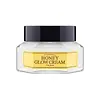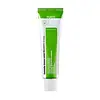What's inside
What's inside
 Key Ingredients
Key Ingredients

 Benefits
Benefits

 Concerns
Concerns

 Ingredients Side-by-side
Ingredients Side-by-side

Water
Skin ConditioningOctyldodecanol
EmollientC12-15 Alkyl Benzoate
AntimicrobialOctyldodecyl Olivate
Skin ConditioningCyclopentasiloxane
EmollientPropylene Glycol Dibenzoate
Skin ConditioningGlyceryl Stearate
EmollientPEG-100 Stearate
Niacinamide
SmoothingBehenyl Olivate
Emulsion StabilisingCetearyl Alcohol
EmollientButylene Glycol
Humectant1,2-Hexanediol
Skin ConditioningEuphorbia Cerifera Wax
Glycerin
HumectantStearyl Behenate
EmollientPolyhydroxystearic Acid
EmulsifyingBehenic Acid
CleansingCetyl Stearate
EmollientStearyl Stearate
EmollientHoney Extract
HumectantAcrylates/C10-30 Alkyl Acrylate Crosspolymer
Emulsion StabilisingXanthan Gum
EmulsifyingArginine
MaskingBoswellia Serrata Resin Extract
SmoothingCinnamomum Cassia Bark Extract
MaskingCurcuma Longa Root Extract
MaskingDisodium EDTA
Adenosine
Skin ConditioningEthylhexylglycerin
Skin ConditioningPollen Extract
EmollientLevan
Skin ProtectingDecyl Glucoside
CleansingOlea Europaea Leaf Extract
PerfumingRoyal Jelly Extract
Skin ConditioningPropolis Extract
Skin ConditioningPhenethyl Alcohol
MaskingZiziphus Jujuba Seed Extract
Skin ConditioningCentella Asiatica Extract
CleansingBee Venom
AstringentCitric Acid
BufferingAscorbic Acid
AntioxidantMadecassoside
AntioxidantParfum
MaskingLimonene
PerfumingCitral
PerfumingButylphenyl Methylpropional
PerfumingGeraniol
PerfumingWater, Octyldodecanol, C12-15 Alkyl Benzoate, Octyldodecyl Olivate, Cyclopentasiloxane, Propylene Glycol Dibenzoate, Glyceryl Stearate, PEG-100 Stearate, Niacinamide, Behenyl Olivate, Cetearyl Alcohol, Butylene Glycol, 1,2-Hexanediol, Euphorbia Cerifera Wax, Glycerin, Stearyl Behenate, Polyhydroxystearic Acid, Behenic Acid, Cetyl Stearate, Stearyl Stearate, Honey Extract, Acrylates/C10-30 Alkyl Acrylate Crosspolymer, Xanthan Gum, Arginine, Boswellia Serrata Resin Extract, Cinnamomum Cassia Bark Extract, Curcuma Longa Root Extract, Disodium EDTA, Adenosine, Ethylhexylglycerin, Pollen Extract, Levan, Decyl Glucoside, Olea Europaea Leaf Extract, Royal Jelly Extract, Propolis Extract, Phenethyl Alcohol, Ziziphus Jujuba Seed Extract, Centella Asiatica Extract, Bee Venom, Citric Acid, Ascorbic Acid, Madecassoside, Parfum, Limonene, Citral, Butylphenyl Methylpropional, Geraniol
Centella Asiatica Extract
CleansingWater
Skin ConditioningCaprylic/Capric Triglyceride
MaskingGlycerin
HumectantSqualane
EmollientCetearyl Alcohol
EmollientButylene Glycol
Humectant1,2-Hexanediol
Skin ConditioningNiacinamide
SmoothingMacadamia Ternifolia Seed Oil
EmollientButyrospermum Parkii Butter Extract
Skin ConditioningHydrogenated Lecithin
EmulsifyingTribehenin
EmollientStearic Acid
CleansingBehenic Acid
CleansingArgania Spinosa Kernel Oil
EmollientTromethamine
BufferingSpent Grain Wax
Skin ConditioningCarbomer
Emulsion StabilisingCaprylyl Glycol
EmollientTremella Fuciformis Extract
HumectantSodium Hyaluronate
HumectantPerilla Ocymoides Seed Extract
AntioxidantHamamelis Virginiana Extract
AntiseborrhoeicBetaine
HumectantBeta-Glucan
Skin ConditioningCitrus Aurantium Bergamia Fruit Oil
MaskingXanthan Gum
EmulsifyingSodium Carbomer
Emulsion StabilisingHydroxyethylcellulose
Emulsion StabilisingAdenosine
Skin ConditioningLavandula Angustifolia Oil
MaskingAsiaticoside
AntioxidantAsiatic Acid
Skin ConditioningPhytosphingosine
Skin ConditioningCeramide NP
Skin ConditioningMadecassic Acid
Skin ConditioningTocopherol
AntioxidantCentella Asiatica Extract, Water, Caprylic/Capric Triglyceride, Glycerin, Squalane, Cetearyl Alcohol, Butylene Glycol, 1,2-Hexanediol, Niacinamide, Macadamia Ternifolia Seed Oil, Butyrospermum Parkii Butter Extract, Hydrogenated Lecithin, Tribehenin, Stearic Acid, Behenic Acid, Argania Spinosa Kernel Oil, Tromethamine, Spent Grain Wax, Carbomer, Caprylyl Glycol, Tremella Fuciformis Extract, Sodium Hyaluronate, Perilla Ocymoides Seed Extract, Hamamelis Virginiana Extract, Betaine, Beta-Glucan, Citrus Aurantium Bergamia Fruit Oil, Xanthan Gum, Sodium Carbomer, Hydroxyethylcellulose, Adenosine, Lavandula Angustifolia Oil, Asiaticoside, Asiatic Acid, Phytosphingosine, Ceramide NP, Madecassic Acid, Tocopherol
 Reviews
Reviews

Ingredients Explained
These ingredients are found in both products.
Ingredients higher up in an ingredient list are typically present in a larger amount.
1,2-Hexanediol is a synthetic liquid and another multi-functional powerhouse.
It is a:
- Humectant, drawing moisture into the skin
- Emollient, helping to soften skin
- Solvent, dispersing and stabilizing formulas
- Preservative booster, enhancing the antimicrobial activity of other preservatives
Adenosine is in every living organism. It is one of four components in nucleic acids that helps store our DNA.
Adenosine has many benefits when used. These benefits include hydrating the skin, smoothing skin, and reducing wrinkles. Once applied, adenosine increases collagen production. It also helps with improving firmness and tissue repair.
Studies have found adenosine may also help with wound healing.
In skincare products, Adenosine is usually derived from yeast.
Learn more about AdenosineBehenic Acid is a fatty acid and has moisturizing properties.
It is naturally occuring in the Moringa oleifera tree, rapeseed oil, and peanut oil.
This ingredient may not be Malassezia folliculitis, or fungal acne safe.
Learn more about Behenic AcidButylene Glycol (or BG) is used within cosmetic products for a few different reasons:
Overall, Butylene Glycol is a safe and well-rounded ingredient that works well with other ingredients.
Though this ingredient works well with most skin types, some people with sensitive skin may experience a reaction such as allergic rashes, closed comedones, or itchiness.
Learn more about Butylene GlycolCentella Asiatica Extract (Centella) is derived from an herb native to Southeast Asia. It is famous for its anti-inflammatory and soothing properties.
Centella is rich in antioxidants and amino acids, such as Madecassic Acid and Asiaticoside.
Studies show the compounds in centella help with:
The combination of all these properties makes centella effective at soothing, hydrating, and protecting the skin.
Other great components of centella include Vitamin A, vitamin C, several B vitamins, and Asiatic Acid.
Fun fact: Centella has been used as a medicine and in food for many centuries. As a medicine, it is used to treat burns, scratches, and wounds.
Learn more about Centella Asiatica ExtractCetearyl alcohol is a mixture of two fatty alcohols: cetyl alcohol and stearyl alcohol. It is mainly used as an emulsifier. Emulsifiers help prevent the separation of oils and products. Due to its composition, it can also be used to thicken a product or help create foam.
Cetearyl alcohol is an emollient. Emollients help soothe and hydrate the skin by trapping moisture.
Studies show Cetearyl alcohol is non-toxic and non-irritating. The FDA allows products labeled "alcohol-free" to have fatty alcohols.
This ingredient is usually derived from plant oils such as palm, vegetable, or coconut oils. There is debate on whether this ingredient will cause acne.
Due to the fatty acid base, this ingredient may not be Malassezia folliculitis safe.
Learn more about Cetearyl AlcoholGlycerin is already naturally found in your skin. It helps moisturize and protect your skin.
A study from 2016 found glycerin to be more effective as a humectant than AHAs and hyaluronic acid.
As a humectant, it helps the skin stay hydrated by pulling moisture to your skin. The low molecular weight of glycerin allows it to pull moisture into the deeper layers of your skin.
Hydrated skin improves your skin barrier; Your skin barrier helps protect against irritants and bacteria.
Glycerin has also been found to have antimicrobial and antiviral properties. Due to these properties, glycerin is often used in wound and burn treatments.
In cosmetics, glycerin is usually derived from plants such as soybean or palm. However, it can also be sourced from animals, such as tallow or animal fat.
This ingredient is organic, colorless, odorless, and non-toxic.
Glycerin is the name for this ingredient in American English. British English uses Glycerol/Glycerine.
Learn more about GlycerinNiacinamide is a multitasking form of vitamin B3 that strengthens the skin barrier, reduces pores and dark spots, regulates oil, and improves signs of aging.
And the best part? It's gentle and well-tolerated by most skin types, including sensitive and reactive skin.
You might have heard of "niacin flush", or the reddening of skin that causes itchiness. Niacinamide has not been found to cause this.
In very rare cases, some individuals may not be able to tolerate niacinamide at all or experience an allergic reaction to it.
If you are experiencing flaking, irritation, and dryness with this ingredient, be sure to double check all your products as this ingredient can be found in all categories of skincare.
When incorporating niacinamide into your routine, look out for concentration amounts. Typically, 5% niacinamide provides benefits such as fading dark spots. However, if you have sensitive skin, it is better to begin with a smaller concentration.
When you apply niacinamide to your skin, your body converts it into nicotinamide adenine dinucleotide (NAD). NAD is an essential coenzyme that is already found in your cells as "fuel" and powers countless biological processes.
In your skin, NAD helps repair cell damage, produce new healthy cells, support collagen production, strengthen the skin barrier, and fight environmental stressors (like UV and pollution).
Our natural NAD levels start to decline with age, leading to slower skin repair, visible aging, and a weaker skin barrier. By providing your skin niacinamide, you're recharging your skin's NAD levels. This leads to stronger, healthier, and younger looking skin.
Another name for vitamin B3 is nicotinamide. This vitamin is water-soluble and our bodies don't store it. We obtain Vitamin B3 from either food or skincare. Meat, fish, wheat, yeast, and leafy greens contain vitamin B3.
The type of niacinamide used in skincare is synthetically created.
Learn more about NiacinamideWater. It's the most common cosmetic ingredient of all. You'll usually see it at the top of ingredient lists, meaning that it makes up the largest part of the product.
So why is it so popular? Water most often acts as a solvent - this means that it helps dissolve other ingredients into the formulation.
You'll also recognize water as that liquid we all need to stay alive. If you see this, drink a glass of water. Stay hydrated!
Learn more about WaterXanthan gum is used as a stabilizer and thickener within cosmetic products. It helps give products a sticky, thick feeling - preventing them from being too runny.
On the technical side of things, xanthan gum is a polysaccharide - a combination consisting of multiple sugar molecules bonded together.
Xanthan gum is a pretty common and great ingredient. It is a natural, non-toxic, non-irritating ingredient that is also commonly used in food products.
Learn more about Xanthan Gum